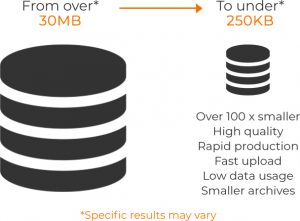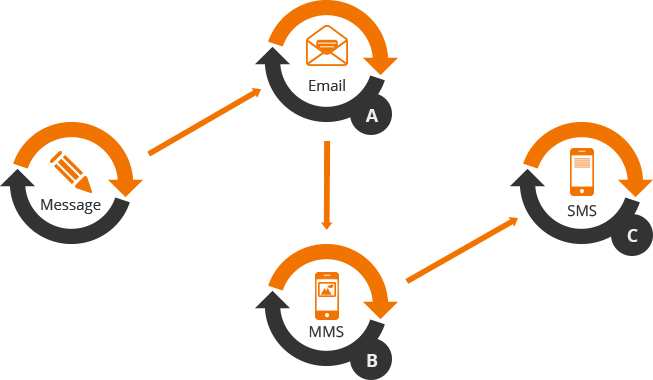Preface – There’s Never Been a Better Time to Review Your CCM Strategy
Throughout the history of business, large enterprises have never had more customers, nor more ways to communicate with them.
At face value, this is an abundance of blessings for leading brands and corporations. After all, when it comes to quantity of customers and quality of customer-contact, more is better than less.
But the everyday reality of managing customer communication programmes today can be daunting, not to mention expensive, now that it involves the use of customer data to create personalised, multi-media experiences dynamically and delivering it securely to millions of individuals in a multitude of channels and formats.
The growing complexity of sending personalised correspondence at scale is one of the factors driving a resurgence of interest in the formerly low-profile category of software and managed services known as Customer Communications Management (CCM).
In fact, the global customer communication management market has been forecast to grow from US $1.4 bn in 2017 to $4 bn by the end of 2024 – a compound annual growth rate of over 16%*.
So what exactly is CCM software and managed services? And how do they help large enterprises deliver personalised communications and experiences at scale?
CCM Defined
Research and advisory company Gartner defines the CCM market as solutions that support:
“The strategy to improve the creation, delivery, storage and retrieval of outbound communications, including those for marketing, new product introductions, renewal notifications, claims correspondence and documentation, and bill and payment notifications.”
“These interactions can happen through a widespread range of media and output, including documents, email, Short Message Service (SMS) and Web pages.”
“CCM solutions support these objectives, providing companies with an application to improve outbound communications with their distributors, partners, regulatory bodies and customers.”
Put another way, the ideal CCM service provider offers an integrated suite of software and managed services to enterprises seeking to deliver personalised communications and experiences to millions of customers in any channel, format or device.
All Together Now
Modern CCM Platforms Must Streamline Multiple Customer Communication Requirements Onto a Single, All-in-One Platform.
Capable of Creating & Delivering Customer Communication Programmes For Any Channel or Format

Compatible With Any Digital or Output Device

At iLiveIt, we generally support Gartner’s definition, although for us the ideal CCM solution-suite must also support:
It is not difficult to send generalised communiques to your customers or discrete customer-segments, but modern CCM solutions must enable the design and delivery of hyper-personalised customer experiences at scale.
To achieve this, modern CCM systems must be capable of creating tens of millions of unique ‘content blocks’ or experiences dynamically guided by information and insights in your customer data.
In many industries – especially banking, telco and insurance – ‘forms’ used for onboarding, renewals or other contractual or information-gathering processes will continue to be essential at crucial moments in the customer life cycle.
However, today’s customers expect companies to save them time and trouble by pre-completing forms with the information that they already have on file and for form-completion / signature / return processes to be simple, fast and effortless (even on a mobile). Modern CCM systems must create easy-to-use, pre-populated forms dynamically and provide positive form-user experiences.
Whereas once customer correspondence comprised mainly words and images – such as in traditional printed documents and emails – CCM platforms today must help enterprises create and deliver personalised infographics and personalised videos at scale, to meet the expectations of time-starved and video-hungry consumers.
Importantly, personalised multi-media files and interactive pdfs must also be compact enough for delivery via MMS (with minimal loss of quality). Therefore, state-of-the-art rendering and file-compression software is an essential element of modern CCM.
Personalised web-pages, paper bills, emails and other touchpoints all provide opportunities to create ‘white spaces’ that can be populated dynamically with super-relevant, hyper-personalised content, information and offers.
Use of apps is now so commonplace that contemporary CCM systems must cater for in-app personalised communications too.
Benefits of CCM
Importantly, while using a state-of-the-art CCM platform can improve the effectiveness and cost-efficiency of your customer acquisition programmes, perhaps CCM’s most significant value-add lies in its potential to improve Net Promotor Scores (NPS), strengthen customer retention and increase the business value of existing customers.
CCM helps companies achieve these goals by:
More Relevant Content
Use customer data to create hyper-personalised information, messages and offers that are more relevant and valuable to recipients.
Improved CX
Connecting multiple channels – such as email, MMS, SMS, In-App, HTML, posted documents and other pathways – on an integrated platform helps deliver smoother, more seamless and more impressive customer experiences.
Satisfaction, Loyalty, Retention
Turn routine and mundane correspondence – such as sign-up forms, onboarding processes, bills, statements, renewal notifications, service information and even payment-reminders – into impressive and engaging touchpoints that surprise, delight and satisfy. The end-game is better NPS outcomes and lower customer churn.
Digital Transformation
Accelerate and upgrade the migration from analogue to digital.
Increasing Customer Lifetime Value
Generate more leads and conversions from existing customers who see value in relevant cross-sell/upsell offers.
Cost Control
Realise the potential for considerable direct and indirect cost savings when moving from multiple independent ‘one-channel specialist vendors’ to an integrated platform that can deliver a diverse array of touchpoints to customers through any channel.
Additionally, super-compression technology reduces the size of personalised videos, HTML, and interactive PDF documents, leading to improved CX and substantial savings on the cost of delivery and archiving.

Mission-Critical CCM Capabilities
With extensive experience providing CCM software and managed services to large enterprises in South Africa, in our view the mission-critical CCM delivery model takes into account key steps and stages needed to create and deploy hyper-personalised customer communications and experiences at scale. These are:
Step 1: Discovery and Planning
CCM strategies and deployment capabilities need to be informed by your business context, capabilities and goals. CCM service providers must help you design the CCM strategy that best fits your business needs, factoring in the requirements of different verticals. Success also rests significantly on your CCM provider’s ability to bring together the business, finance, IT, brand and marketing functions of your organisation, and cater for their unique needs where necessary.
CCM – WHY NOW?
“Now more than ever, customers expect companies to value their loyalty, recognise them as individuals, be cognizant of their personal needs and requirements and send them only the most relevant information or offers. They also want to be contacted at just the right time via their choice of digital, mobile or print channel and given fresh, engaging, user-friendly experiences. CCM enables companies to deliver these goals.”
Step 2: Data Preparation
Using customer data to create more relevant information, offers and experiences for customers is one of the most valuable benefits of an integrated CCM capability. But to be effective your data will need to be verified and cleaned, loaded into the CCM system, mapped to the design and functionality of your customer-correspondence (so that it can be produced dynamically at scale) and managed with world-class security/protection software.
Step 3: Touchpoint Design and Creation
A true omnichannel CCM provider must be capable of helping you design and produce customer communication tools and experiences in any form. That includes technically challenging capabilities such as creating personalised videos dynamically at scale and massive file-size compression for delivery in MMS.
Step 4: Omni-Channel Delivery
Integrated all-in-one communication platforms create seamless and impressive customer experiences. They also make it easier to set up “Failover Rules”, so that if emails go unopened, MMS and/or SMS correspondence is triggered automatically (and if that fails, customer service centres can be alerted automatically if needed). Failover systems lower the number of customers who would otherwise not receive your correspondence.

Step 5: Evaluation and Records Archiving
CCM support systems should also:
- Enable the efficient storage and archiving for every individual personalised touchpoint created and sent
- Give authorised call-centre/technical staff rapid access to any touchpoint sent to customers and also to Audit Log records
- Provide ongoing tracking or one-off performance reports
Summary
Now more than ever, customers expect companies to value their loyalty, recognise them as individuals, be cognizant of their personal needs and requirements and send them only the most relevant information or offers. They also want to be contacted at just the right time via their choice of digital, mobile or print channel and given fresh, engaging, user-friendly experiences. CCM enables companies to deliver these goals.
Moreover, medium-range GDP growth forecasts in the world’s most advanced developed economies are anaemic – typically 1-2%. In this lack-lustre business environment, it’s never been more critical for large enterprises to retain customers, raise the business value of every customer relationship and to control costs. State-of-the-art CCM systems help achieve these goals by enabling enterprises to send more relevant and compelling information and offers to customers in formats that delight them through whatever channel they prefer.
Importantly, CCM also enables companies to streamline and simplify their customer-communications infrastructure onto a single, cost-efficient and easy-to-deploy rules-based platform that connects to other parts of the organisation, such as customer service centres. In our opinion, the best CCM platforms are simple, fast and cost-efficient to set up, with minimal “systems integration” tasks and offer high levels of flexibility so that can be optimised to meet the needs and requirements of different companies and industries.
- WIRE, B. (2018). Global Customer Communication Management (CCM) Market Outlook to 2024 – A $4.04 Billion Opportunity, Growing at a CAGR of 16.88% – ResearchAndMarkets.com. [online] Businesswire.com. Available at: https://www.businesswire.com/news/home/20180709005378/en/Global-Customer-Communication-Management-CCM-Market-Outlook [Accessed 25 Oct. 2018].
- Gartner IT Glossary. (2018). Customer Communications Management (CCM) – Gartner IT Glossary. [online] Available at: https://www.gartner.com/it-glossary/customer-communications-management-ccm [Accessed 25 Oct. 2018].
- Source: Research & Markets Global Customer Communication Management (CCM) Market – Premium Insight, Industry Trends, Company Usability Profiles, Market Sizing & Forecasts to 2024 report, https://www.researchandmarkets.com/research/brtgdx/global_customer?w=4
Request More Information On
What The World’s Smartest CCM Platform Could Do For Your Business
We are happy to provide some examples and answer your questions.


 Print article
Print article